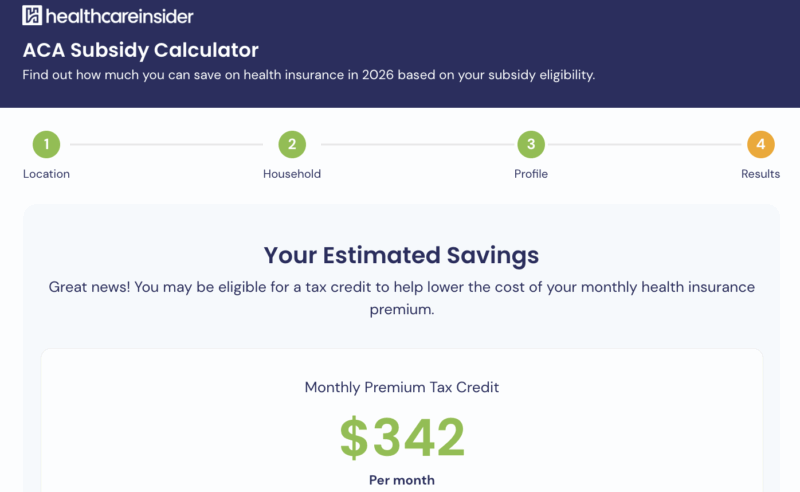Written by Michael LaPick
Healthcare Writer
We want to help you make educated healthcare decisions. While this post may have links to lead generation forms, this won’t influence our writing. We adhere to strict editorial standards to provide the most accurate and unbiased information.
Key Takeaways
- Health insurance premiums are increasing due to inflation, higher healthcare use, and ACA market shifts.
- You can reduce costs by shopping for plans, updating subsidy info, or choosing the right metal tier.
- Short-term medical, supplemental, and fixed-benefit plans can help bridge coverage gaps affordably.
- Using preventive care and staying in-network keeps medical costs lower over time.
- State, employer, and ACA subsidies can all play a role in reducing what you pay.
Why Are Health Insurance Premiums Going Up?
If your monthly health insurance premium feels higher this year, you’re not imagining it. According to the Kaiser Family Foundation (KFF), average ACA plan premiums are projected to rise in many states, driven by several factors.
Healthcare inflation continues to push up costs for hospital care, prescription drugs, and medical staff. At the same time, more Americans are using healthcare services—especially for chronic and mental health care—which raises insurer costs. Some of the temporary federal subsidies created during the pandemic have also ended, increasing out-of-pocket premiums for certain households. Finally, insurers have adjusted their rates after several years of underpricing to reflect actual claim trends.
If you’re curious which providers are offering the most competitive coverage, you can explore the best health insurance companies for 2025 to compare reputation, value, and network quality before enrolling.
How to Reduce Health Insurance Costs Without Losing Coverage
These proven strategies can help you manage your monthly premium and protect your coverage.
1. Shop Around During Open Enrollment
Premiums, benefits, and provider networks change every year. Comparing plans during Open Enrollment could uncover new savings opportunities.
Use a licensed insurance agent to review ACA plans in your area. If you’re comparing multiple states or local marketplaces, our guide to health insurance options by state helps you find available plans, enrollment deadlines, and coverage rules near you.
2. Adjust Your Plan’s Metal Tier Strategically
ACA marketplace plans come in four “metal” tiers—Bronze, Silver, Gold, and Platinum—each balancing premiums with out-of-pocket costs.
- Bronze plans have the lowest premiums but the highest deductibles, making them best for people who rarely visit the doctor.
- Silver plans are moderate in both premium and cost-sharing and may qualify for cost-sharing reductions (CSRs).
- Gold plans have higher premiums but lower deductibles, ideal for those who need regular care.
- Platinum plans offer the lowest out-of-pocket costs but the highest monthly premiums, suited for those with ongoing medical needs.
If you qualify for CSRs, Silver plans often provide the best value overall.
3. Maximize ACA Subsidies in 2026
ACA subsidies, also called premium tax credits, help lower the monthly cost of health insurance for people who buy ACA Marketplace plans through the federal marketplace (HealthCare.gov) or a state exchange. These subsidies reduce your monthly premium amount based on your income, household size, and location.
To qualify for ACA subsidies in 2026, your income must fall within a specific range — high enough that you don’t qualify for Medicaid, but not so high that you’re no longer eligible for financial help. For now, it’s projected that individuals and families with household incomes between 100% and 400% of the Federal Poverty Level (FPL) will generally qualify for subsidies in the form of Premium Tax Credits.
How the Math Works
ACA subsidy eligibility is calculated using federal poverty guidelines from the previous year (so 2026 coverage uses 2025 FPL numbers). Here’s what that looks like in practical terms:
-
Single person:
-
100% of the FPL = about $15,650 per year (or $1,304 per month)
-
400% of the FPL = about $62,600 per year (or $5,217 per month)
-
-
Family of four:
-
100% of the FPL = about $32,150 per year (or $2,679 per month)
-
400% of the FPL = about $128,600 per year (or $10,717 per month)
-
If your annual household income falls within these ranges, you’ll likely qualify for ACA subsidies that lower your monthly premium. The exact amount depends on your income and where you live.
You can estimate your savings by using our ACA Subsidy Calculator to see how much help you might receive toward your monthly premium.
Always update your income estimate each year through HealthCare.gov or your state exchange. Even small income changes can affect your eligibility or the amount of your subsidy. Keeping your information current ensures you receive every dollar of financial help available.
These figures are estimates based on 2025 federal poverty guidelines and are used to determine eligibility for 2026 ACA premium tax credits.
A friendly team of licensed insurance agents is here to guide you.
4. Contribute to a Health Savings Account (HSA)
If you’re enrolled in a High-Deductible Health Plan (HDHP), an HSA lets you save pre-tax money for medical expenses. You’ll reduce your taxable income, grow funds tax-free, and pay no taxes on qualified withdrawals—a triple tax advantage.
For example, if you contribute $3,000 annually to an HSA and are in the 22% tax bracket, you could save about $660 in taxes each year.
5. Stay In-Network and Use Preventive Care
Out-of-network providers often charge double or more compared to in-network rates. Use your insurer’s directory to confirm that your doctors and facilities are in-network. Take advantage of preventive services—such as annual checkups, screenings, and vaccinations—which ACA-compliant plans must cover at no cost.
6. Explore State or Employer Coverage Options
Some states extend premium subsidies beyond federal ACA assistance. If you have employer-sponsored coverage, ask about wellness programs, Flexible Spending Accounts (FSAs), or telehealth incentives that can help lower your overall medical costs.
7. Explore Alternative ACA Plan Options
If you or your family aren’t eligible for ACA subsidies, alternative plans may provide flexible, affordable coverage that bridges the gap between traditional policies.
Short-Term Medical Plans
These temporary, lower-cost plans offer basic protection between coverage periods. They are ideal for people between jobs, recent graduates, or gig workers. Short-term medical (STM) plans provide fast enrollment (sometimes the next day), preventive care, telemedicine, and access to national provider networks. However, they are not ACA-compliant and may exclude preexisting conditions.
To learn more about STM carriers and plan options, explore our best short-term health insurance companies of 2025 roundup.
Supplemental Insurance
These plans are best for those with high deductibles or limited coverage. Supplemental options—like accident, hospital, critical illness, or cancer insurance—can be added anytime and pay fixed benefits directly to you, helping cover unexpected medical expenses.
Dental and Vision Insurance
Perfect for families, students, or individuals on a budget. These plans cover routine exams, cleanings, and eyewear while offering bundled savings and early detection of health issues.
Health Care Sharing Ministries
Faith-based programs where members share medical expenses through monthly contributions instead of traditional premiums. They can be budget-friendly and value-driven, but are not regulated as insurance and don’t guarantee payment.
Fixed Benefit Medical Insurance
Designed for low-income or self-employed individuals, these plans pay set dollar amounts for specific services (for example, a flat payment for each doctor visit). They can work alongside other coverage and often offer direct cash payments without network restrictions.
You can also compare available marketplace and non-marketplace options in your area through our overview of healthcare marketplace alternatives.
Bottom Line: Small Adjustments, Big Savings
You can lower your health insurance premium without giving up quality coverage. By shopping during Open Enrollment, taking advantage of preventive care, optimizing subsidies, and exploring alternative options, you can strike the right balance between cost and coverage.
Healthcare costs may continue to rise, but with smart planning and regular review, you can stay protected and keep your premiums manageable.
Thank you for your feedback!







